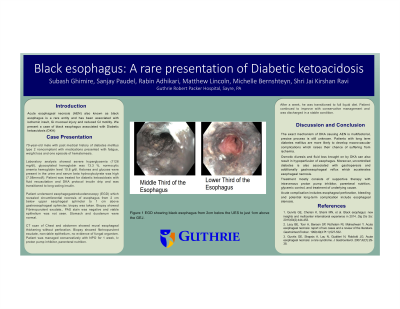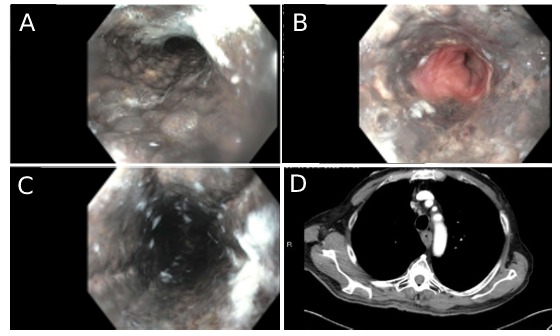Monday Poster Session
Category: General Endoscopy
P2012 - Black Esophagus: A Rare Presentation of Diabetic Ketoacidosis
Monday, October 23, 2023
10:30 AM - 4:15 PM PT
Location: Exhibit Hall

Has Audio
- SG
Subash Ghimire, MD
Guthrie Robert Packer Hospital
Sayre, PA
Presenting Author(s)
Subash Ghimire, MD, Sanjay Paudel, MD, Rabin Adhikari, MD, Matthew Lincoln, DO, Michelle Bernshteyn, MD, Shri Jai Kirshan Ravi, MD
Guthrie Robert Packer Hospital, Sayre, PA
Introduction: Acute esophageal necrosis (AEN) also known as black esophagus is a rare entity and has been associated with ischemic insult, Gi mucosal injury, and reduced GI motility. We present a case of black esophagus associated with Diabetic ketoacidosis (DKA)
Case Description/Methods: A 70-year-old male with the past medical history of diabetes mellitus type 2 noncompliant with medications presented with fatigue, weight loss, and one episode of hematemesis. Laboratory analysis showed severe hyperglycemia (1126 mg/dl), glycosylated hemoglobin was 13.3 %, and ketoacidosis. The patient was treated for diabetic ketoacidosis with fluid resuscitation and DKA protocol insulin drip and was transitioned to long-acting insulin.
The patient underwent esophagogastroduodenoscopy (EGD) which revealed circumferential necrosis of the esophagus from 2 cm below the upper esophageal sphincter to 1 cm above the gastroesophageal sphincter, and a biopsy was taken. The stomach and duodenum were normal. CT Chest and abdomen showed mural esophageal thickening without perforation. Biopsy showed fibrinopurulent exudate, nonviable epithelium, and no evidence of fungal organisms. The patient was managed conservatively with NPO for 1 week, a proton pump inhibitor, and parenteral nutrition. After a week, he was transitioned to a full liquid diet. The patient continued to improve with conservative management and was discharged in stable condition.
Discussion: DKA has previously been linked to AEN in a number of case reports. The exact mechanism of DKA causing AEN is multifactorial, the precise process is still unknown. Patients with long-term diabetes mellitus are more likely to develop macrovascular complications which raises their chance of suffering from ischemia. Ischemic state and compromised mucosal barrier against corrosive injury to gastric contents have been linked to malnutrition with hemodynamic instability and hyperglycemia
There is no established standard treatment for AEN. Treatment mostly consists of supportive therapy with an intravenous proton pump inhibitor, parenteral nutrition, glycemic control, and treatment of the underlying cause. Acute complication includes esophageal perforation, bleeding, and potential long-term complication include esophageal stenosis.
Clinicians should have a high suspicion of AEN in elderly patients, and poorly controlled diabetes with other co-morbidities when they present with mild dysphagia or hematemesis. Early diagnosis and treatment is the key to this rare entity.

Disclosures:
Subash Ghimire, MD, Sanjay Paudel, MD, Rabin Adhikari, MD, Matthew Lincoln, DO, Michelle Bernshteyn, MD, Shri Jai Kirshan Ravi, MD. P2012 - Black Esophagus: A Rare Presentation of Diabetic Ketoacidosis, ACG 2023 Annual Scientific Meeting Abstracts. Vancouver, BC, Canada: American College of Gastroenterology.
Guthrie Robert Packer Hospital, Sayre, PA
Introduction: Acute esophageal necrosis (AEN) also known as black esophagus is a rare entity and has been associated with ischemic insult, Gi mucosal injury, and reduced GI motility. We present a case of black esophagus associated with Diabetic ketoacidosis (DKA)
Case Description/Methods: A 70-year-old male with the past medical history of diabetes mellitus type 2 noncompliant with medications presented with fatigue, weight loss, and one episode of hematemesis. Laboratory analysis showed severe hyperglycemia (1126 mg/dl), glycosylated hemoglobin was 13.3 %, and ketoacidosis. The patient was treated for diabetic ketoacidosis with fluid resuscitation and DKA protocol insulin drip and was transitioned to long-acting insulin.
The patient underwent esophagogastroduodenoscopy (EGD) which revealed circumferential necrosis of the esophagus from 2 cm below the upper esophageal sphincter to 1 cm above the gastroesophageal sphincter, and a biopsy was taken. The stomach and duodenum were normal. CT Chest and abdomen showed mural esophageal thickening without perforation. Biopsy showed fibrinopurulent exudate, nonviable epithelium, and no evidence of fungal organisms. The patient was managed conservatively with NPO for 1 week, a proton pump inhibitor, and parenteral nutrition. After a week, he was transitioned to a full liquid diet. The patient continued to improve with conservative management and was discharged in stable condition.
Discussion: DKA has previously been linked to AEN in a number of case reports. The exact mechanism of DKA causing AEN is multifactorial, the precise process is still unknown. Patients with long-term diabetes mellitus are more likely to develop macrovascular complications which raises their chance of suffering from ischemia. Ischemic state and compromised mucosal barrier against corrosive injury to gastric contents have been linked to malnutrition with hemodynamic instability and hyperglycemia
There is no established standard treatment for AEN. Treatment mostly consists of supportive therapy with an intravenous proton pump inhibitor, parenteral nutrition, glycemic control, and treatment of the underlying cause. Acute complication includes esophageal perforation, bleeding, and potential long-term complication include esophageal stenosis.
Clinicians should have a high suspicion of AEN in elderly patients, and poorly controlled diabetes with other co-morbidities when they present with mild dysphagia or hematemesis. Early diagnosis and treatment is the key to this rare entity.

Figure: Upper endoscopy images (A, B, C) showing black pigmentation of the esophagus.CT imaging (D) shows the thickening of the esophageal wall
Disclosures:
Subash Ghimire indicated no relevant financial relationships.
Sanjay Paudel indicated no relevant financial relationships.
Rabin Adhikari indicated no relevant financial relationships.
Matthew Lincoln indicated no relevant financial relationships.
Michelle Bernshteyn indicated no relevant financial relationships.
Shri Jai Kirshan Ravi indicated no relevant financial relationships.
Subash Ghimire, MD, Sanjay Paudel, MD, Rabin Adhikari, MD, Matthew Lincoln, DO, Michelle Bernshteyn, MD, Shri Jai Kirshan Ravi, MD. P2012 - Black Esophagus: A Rare Presentation of Diabetic Ketoacidosis, ACG 2023 Annual Scientific Meeting Abstracts. Vancouver, BC, Canada: American College of Gastroenterology.
